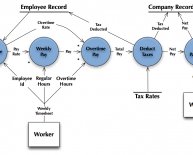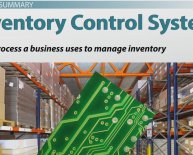
Importance of inventory control system
 I used to dread the word “inventory”. As a part-time cashier in high school, the word inventory only meant one thing: lots and lots of counting. It’s common for businesses to reconcile their inventory at the end of the year by counting up all their physical product and making sure it matches what's on the books. For big companies like the one I used to work for, this requires all hands on deck!
I used to dread the word “inventory”. As a part-time cashier in high school, the word inventory only meant one thing: lots and lots of counting. It’s common for businesses to reconcile their inventory at the end of the year by counting up all their physical product and making sure it matches what's on the books. For big companies like the one I used to work for, this requires all hands on deck!
These days, I understand just how important solid inventory management is. Inventory is a placeholder for money. You paid money for it, and you’ll get that money back (and then some) when you sell it.
Why Inventory Management Is Important
Sitting on inventory ties up a lot of cash. That's why good inventory management is crucial for growing a company. Just like cash flow, it can make or break your business.
Inventory Management Saves You Money
Good inventory management saves you money in a few critical ways:
Avoid Spoilage
If you’re selling a product that has an expiry date (like food or makeup), there’s a very real chance it will go bad if you don’t sell it in time. Solid inventory management helps you avoid unnecessary spoilage.
Avoid Dead Stock
Dead stock is stock that can no longer be sold, but not necessarily because it expired. It could have gone out of season, out of style, or otherwise become irrelevant. By managing your inventory better, you can avoid dead stock.
Save on Storage Costs
Warehousing is often a variable cost, meaning it fluctuates based on how much product you’re storing. When you store too much product at once or end up with a product that’s difficult to move, your storage costs will go up. Avoiding this will save you money.
Inventory Management Improves Cash Flow
Not only does good inventory management save you money, it also improves cash flow in other ways. Remember, it’s product that you’ve paid for with cash, and you’re going to sell for cash, but while it’s sitting in your warehouse it is definitively not cash. Just try paying your landlord with 500 iPhone cases.
This is why it’s important to factor inventory into your cash flow management. It affects both sales (by dictating how much you can sell), and expenses (by dictating what you have to buy). Both of these things factor heavily into how much cash you have on hand. Better inventory management leads to better cash flow management.
When you have a solid inventory system, you’ll know exactly how much product you have, and based on sales, you can project when you’ll run out and make sure you replace it on time. Not only does this make sure you don’t lose sales (critical for cash flow), but it also helps you plan ahead for buying more so you can ensure you have enough cash set aside.
Money spent on inventory is money that is not spent on growth. Manage it wisely.
8 Inventory Management Techniques
Inventory management is a highly variable part of doing business. The optimal system is different for each company. However, every business should strive to remove human error from inventory management as much as possible. This means taking of advantage inventory management software. If you run your business with Shopify, inventory management is already built in.
Regardless of the system you use, the following eight techniques to will help you improve your inventory management—and cash flow!
1. Set Par Levels
Make inventory management easier by setting “par levels” for each of your products. Par levels are the minimum amount of product that must be on hand at all times. When your inventory stock dips below the predetermined levels, you know it’s time to order more. You’ll typically order the minimum quantity that will get you back above par. Par levels will vary by product based on how quickly the item sells, and how long it takes to get back in stock.
Although it requires some research and decision-making up front, setting par levels will systemize the process of ordering. Not only will it make it easier for you to make decisions quickly, it will allow your staff to make decisions on your behalf.
Remember that conditions change over time. Check on par levels a few times throughout the year to confirm they still make sense. If something changes in the meantime, don’t be afraid to adjust your par levels up or down.
2. First-In First-Out (FIFO)
“First-in, first-out” is an important principle of inventory management. It means that your oldest stock (first-in) gets sold first (first-out), not your newest stock. This is particularly important for perishable products so you don’t end up with unsellable spoilage.
It’s also a good idea to practice FIFO for non-perishable products. If the same boxes are always sitting at the back, they’re more likely to get worn out. Plus, packaging design and features often change over time. You don’t want to end up with something obsolete that you can’t sell.
In order to manage a FIFO system, you’ll need an organized warehouse. This typically means adding new products from the back, or otherwise making sure old product stays at the front. If you’re working with a warehousing and fulfillment company they probably do this already, but it's a good idea to call them to confirm.
3. Manage Relationships
Part of successful inventory management is being able to adapt quickly. Whether you need to return a slow selling item to make room for a new product, restock a fast seller very quickly, troubleshoot manufacturing issues, or temporarily expand your storage space, it’s important to have a good relationship with your suppliers. That way they’ll be more willing to work with you to solve problems.

















